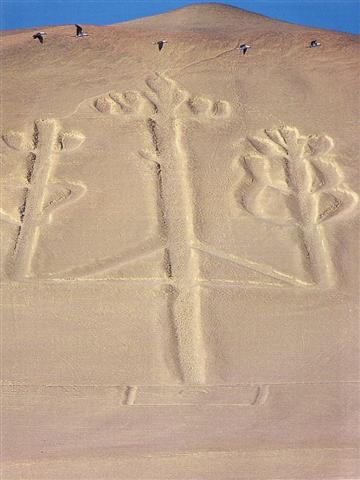4. We should remember the 'Candelabra of the Andes' (cfr at Te Kioe Uri):  ... We came across the water from the north in a small open boat, skirting the arid Balestas islands, now a marine sanctuary, and heading for the Paracas peninsula, where rolling sandstone hills and escarpments drop steeply into the sea. From more than 15 kilometers off-shore we had been able to make out the so-called 'Candelabra of the Andes', first through binoculars and then in direct sight. It lay due south of us, carved into a sloping cliff, looming ever larger in our field of view as we approached. The scholarly consesus is that this huge earth-diagram could easily be 2000 years old and is most likely to have been the work of the same people who created the better-known Nazca lines which are found inland, some 300 kilometers to the south. This 'Nazca culture', about which very little is known, is thought to have flourished from the second century BC until about 600 AD. The 'Candelabra' has a rectangular, box-like base, enclosing a circle, out of which rises the representation of a wide central vertical bar, more than 240 meters in length, running north to south. This is crossed, about one-third of the way up, by a triangular contraption running east to west for some 120 meters, supporting two shorter vertical bars. All three bars are surmounted by curious patterns generally interpreted as flames or rays of light. Because of its auspicious geodetic location half-way round the world from Angkor and 108 degrees west of Giza - sites that both 'resemble the sky' by modelling specific constellations on the ground - we have naturally considered the possibility that the Candelabra could be a work of celestial imitation. What particularly invites this enquiry is the orientation of the diagram. It is set very closely to true north-south, the meridian of the sky, the great dividing-line across which astronomers in all cultures have traditionally observed the 'transits' of stars. The Candelabra was intended by its designers to be seen from the north. Indeed, there is no other perspective from which it may be satisfactorily viewed: the observer must face south towards the sloping escarpment on which it is carved. Examining the diagram from the base up naturally draws the eyes towards the southern sky above the escarpment, and specifically towards the south meridian. Although it may be entirely coincidental, computer simulations tell us that at around the hour of midnight on the March equinox 2000 years ago - the epoch in which the Candelabra was probably made - the constellation known as Crux (the Southern Cross) would have been seen lying on the south meridian at an altitude of 52 degrees. At that moment an observer positioned on a boat as we now were, about a kilometre north of the Candelabra, would have seen the Southern Cross suspended in the sky directly above the great cliff diagram.' Today Crux ought to pass the meridian at midnight about 230 days away from its heliacal rising in September:
Counting from our own calendar we will find the heliacal rising of Mimosa to be ca 365 - (130 + 144) = 91 days before January 1. The Mimosa plant in the sky is tickled in the evening, in fall, when its star at the end of Crux is rising heliacally. Maybe it is the touch of Sun which results in her temporary swoon. The midnight culmination of Crux could be around 228 days earlier than the end of September. The distance from heliacal rising and culmination at noon to culmination at midnight was presumably measured as 228 days and therefore also the distance from culmination at midnight to heliacal descending after culmination at noon could be 228 days. 2 * 228 = 456 points at Botein as an important star:
But the distance to Mimosa is 193.9 - (455.9 - 408) = 146 days = (472 - 456) + 130. 274 (October 1) - 146 = 128 (May 8) = March 21 (80) + 48. By the way, Gb8-12--13 is probably indicating another vero season, when the head of Medusa is severed (at 3h or at the heliacal rising of Algol). From vero at 3h to vero at the end of September there are 146 days. 146 = 2 / 5 * 365. Moving backwards in time 228 glyphs from the heliacal rising of Mimosa: 228 - 130 (Ga5-19) = 98, and 472 - 98 = 374. 374 is 'one more' than the glyph number for Gb5-19 (and also equal to 274 + 100). 374 + 64 = *438. 274 (October 1) - 228 = 46 (February 15). February 15 + (13 + 21) = March 21 at 0h. 408 - (13 + 21) = 374:
The first star of Crux (δ) would culminate at midnight in February 7 (at glyph 366). 366 + 228 - 472 = 122 and 122 + 64 = *186. 2000 years ago, Graham Hancock says, the midnight culmination of Crux was in March. Counting with the precession it means nowadays the culmination would be around 2000 / 72 = 28 days later, i.e. probably in April. Counting 28 days backwards from February 15 (Mimosa at Gb5-20) we will reach glyph number 374 - 28 = 346 and January 17:
|











